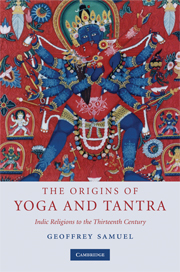Book contents
- Frontmatter
- Contents
- List of figures
- Preface
- 1 Introduction
- 2 Stories and sources
- PART ONE MEDITATION AND YOGA
- 3 The Second Urbanisation of South Asia
- 4 Two worlds and their interactions
- 5 Religion in the early states
- 6 The origins of the Buddhist and Jaina orders
- 7 The Brahmanical alternative
- 8 Interlude: Asceticism and celibacy in Indic religions
- PART TWO TANTRA
- References
- Index
8 - Interlude: Asceticism and celibacy in Indic religions
Published online by Cambridge University Press: 05 June 2012
- Frontmatter
- Contents
- List of figures
- Preface
- 1 Introduction
- 2 Stories and sources
- PART ONE MEDITATION AND YOGA
- 3 The Second Urbanisation of South Asia
- 4 Two worlds and their interactions
- 5 Religion in the early states
- 6 The origins of the Buddhist and Jaina orders
- 7 The Brahmanical alternative
- 8 Interlude: Asceticism and celibacy in Indic religions
- PART TWO TANTRA
- References
- Index
Summary
Chapters 3 to 7 have presented a survey of the evidence relating to the first stages of the history of Indic religions from the Second Urbanisation onwards. Key issues here have included the growth of the ascetic orders and of Brahmanical asceticism and the development of a series of new techniques of mind-body cultivation in the context of these ascetic groups. We have also seen something of the wider context of these ascetic traditions in the religious life of North Indian communities (particularly in relation to the so-called yakṣa religion) and looked forward to a glimpse of the ‘mature’ relationship between Buddhism or Jainism and village religion on the one hand, and Brahmanical religion on the other. In this Interlude, I step back a little to look at some further issues relating to these developments.
I start by asking why the ascetic orders and the new goal of liberation from rebirth developed at the time when it did. Who and what were the Buddha, Pārśva, Mahāvīra, Makkhali Gosāla and the other spiritual leaders of the śramaṇa tradition, to the extent that we can take them as historical figures?
Each generation notoriously remakes major historical figures such as the Buddha or Mahāvīra in its own image and we can hardly expect our own time to be exempt from such a rule.
- Type
- Chapter
- Information
- The Origins of Yoga and TantraIndic Religions to the Thirteenth Century, pp. 173 - 190Publisher: Cambridge University PressPrint publication year: 2008



